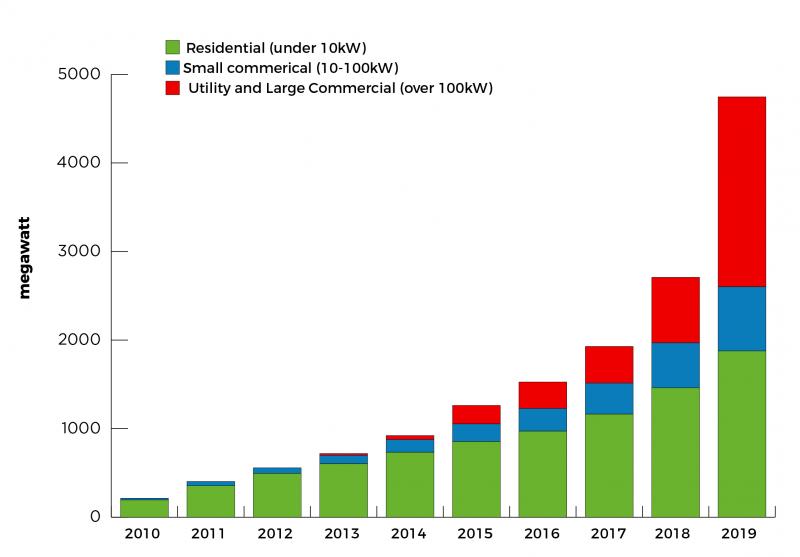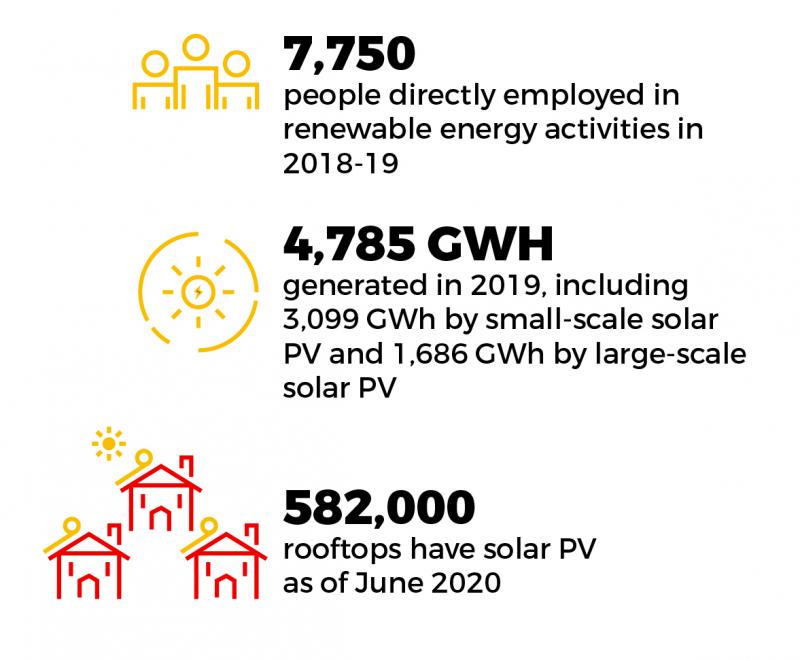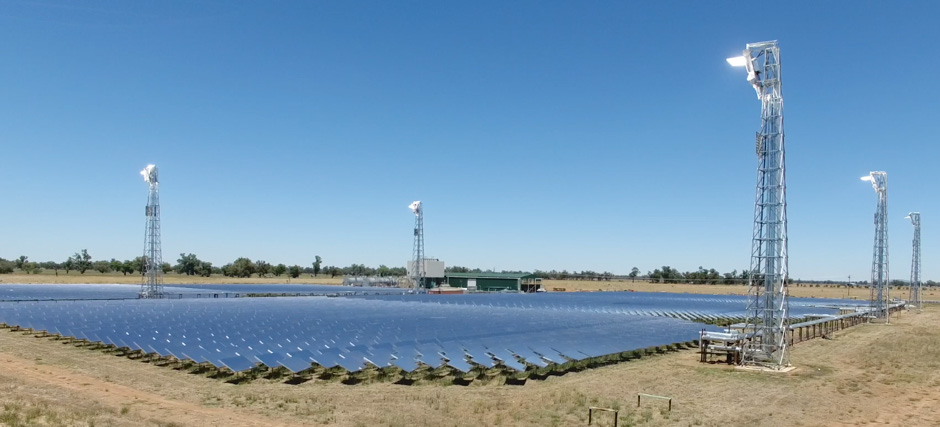Solar energy, a growing part of NSW's energy mix
NSW is a leader in the development of large-scale solar projects. These solar farms support jobs and investment in regional NSW, help to diversify the State’s energy mix and drive down costs for future large-scale solar developments.
There are 16 major operating large-scale solar farms in NSW. Solar farms use the same technology as rooftop solar systems, but on a larger scale.
| Operating Solar Farms | MW |
|---|---|
| Beryl Solar Farm | 87 |
| Bomen Solar Farm | 100 |
| Broken Hill Solar Plant | 53 |
| Coleambally Solar Farm | 150 |
| Dubbo Solar Hub | 15 |
| Finley Solar Farm | 162 |
| Goonumbla Solar Farm | 70 |
| Griffith Solar Farm | 36 |
| Gullen Solar Farm | 10 |
| Limondale Solar Farm Stage 1 | 29 |
| Manildra Solar Farm | 46 |
| Moree Solar Farm | 56 |
| Narromine Solar Farm (Dubbo Solar Hub) | 11 |
| Nyngan Solar Plant | 102 |
| Parkes Solar Farm | 66 |
| White Rock Solar Farm | 20 |

The share of solar and wind in NSW's energy mix has more than DOUBLED from 5% in 2015 to 12% in 2019.

*as of June 2020
NSW households and businesses are also seeing the benefits of solar.

This graph shows the strong growth of solar across all scales from rooftops all the way to solar farms connecting to the electricity grid.

Types of solar energy
Solar energy is generated by using particles of light (photons) as separate sunlight particles or in wave-mode. Solar photovoltaic (PV) cells convert the energy inside the particle directly into electricity.
Solar thermal technologies on the other hand use the wave-like nature of sunlight to create heat. Concentrated solar thermal (CST) power systems focus sunlight on a single point. The heat energy captured can be stored in water, air, or molten salts and then converted to electricity as required.
The future of solar energy in NSW
Small scale
By 2038, the Australian Energy Market Operator has projected that the total installed capacity of PV systems in NSW will be:
- 6,070 MW for residential (less than 10 kW capacity)
- 2,003 MW for businesses (greater than 10 kW capacity).
Solar PV systems have become significantly cheaper in recent years, increasing in popularity from small-scale home rooftop systems to large-scale solar projects. Concentrated solar thermal systems can be installed with energy storage systems.
The development of battery storage technologies is expected to play an important role in growing solar energy.
Large scale
According to the International Energy Agency, solar energy is the most abundant energy resource on earth, with about 885 million terawatt hours (TWh) reaching the surface of the planet every year.
Australia has the highest average solar radiation per square metre of any continent in the world. With excellent solar resources and established electricity infrastructure, NSW is an attractive opportunity for solar farm developers.
Concentrated solar thermal
While solar hot water systems are commonly used, producing electricity from concentrated solar thermal energy is still in its early stages in Australia. Currently, the CSIRO’s solar research thermal hub in Newcastle is Australia’s largest solar thermal research facility. The Jemalong Concentrated Solar Power Pilot Plant, which manages innovative heat transfer and storage technology, is under construction near Forbes.

Assessing large-scale solar projects in NSW
Large-Scale Solar Energy Guideline
The aim of the Large-Scale Solar Energy Guideline is to provide the community, industry, applicants and regulators with information on the planning framework for the assessment and approval of State-significant large-scale solar energy.
Large-scale solar projects in NSW are subject to planning controls and assessment criteria. The total capital value of the project generally determines which authoritative body will approve the development application.
In general, projects with a capital value of:
- less than $5 million are assessed and approved by the local council(s)
- between $5-30 million are assessed by the local council(s), and approved by the relevant Regional Planning Panel
- more than $30 million (or $10 million if in an environmentally sensitive area) are classified as State significant developments and assessed by the NSW Department of Planning, Industry and Environment (DPIE).
For State significant solar developments, the planning process requires the applicant to prepare an Environmental Impact Statement (EIS) that details potential environment, social and economic impacts and proposed management and mitigation measures.
Key project considerations
Agricultural land
Most large-scale solar projects in NSW are located in regional areas as these areas have strong solar resources and availability of land. Potential land use conflicts between existing agricultural land uses in these areas and solar energy development is a key issue that typically requires detailed assessment in the planning process.
The Large-Scale Solar Energy Guideline recommends that large-scale solar energy development applicants consider the location and nature of important agricultural lands, including Biophysical Strategic Agricultural Land (BSAL), irrigated cropping land and land capability classes 1, 2 and 3 in the site selection and design process. The guideline also recommends that consideration be given to any significant fragmentation or displacement of agricultural industries and any cumulative impacts of multiple developments.
These constraints do not preclude the development of large-scale solar energy developments on agricultural land, however, they do indicate issues which may exist and that applicants should carefully consider and address to maintain compatibility of solar development with agricultural land.
Traffic and road safety
The impact of increased traffic is generally limited to the construction of solar farms, with activities like the haulage of components and materials to the site and contractor and employee movements. This may temporarily affect local traffic, but these movements are typically confined to standard hours of construction and the solar farm must repair any damage to the roads. These impacts are managed in consultation with the Transport for NSW, local councils and landholders. They also form part of any EIS and include measures to reduce risk and ensure safety.
Visual
Photovoltaic panels are designed to maximise efficiency, absorb sunlight and convert it to electricity, which means they’re designed to reflect as little light as possible. Usually, it’s around 2% of the light received. In fact, the glare from panels is significantly less than that from bodies of water. Where appropriate, planning approvals may include requirements for vegetation buffers to help minimise visual impacts.
Biodiversity
The Large-Scale Solar Energy Guideline recommends solar farms be located in areas that minimise the need for clearing of native vegetation. Re-planting is an option if clearing is unavoidable. Any EIS will examine the individual circumstances of a solar farm proposal and its effect on the surrounding environment, including potential impacts on native vegetation, habitat of threatened species or ecological communities.
Aboriginal cultural heritage
Any likely impacts on cultural and archaeological objects, places and heritage (including Aboriginal objects and places) will be assessed through the planning process, and the local Aboriginal community and relevant government agencies will be consulted if impacts are expected.
Noise
Solar farms generally emit minimal noise. Potential sources of noise include inverters, transformers and cooling fans used for temperature regulation. These are typically contained inside buildings in the middle of the development to reduce noise to the surrounding environment. Noise during the construction and operation of solar farms is assessed in the EIS and considered in the planning process.
Emissions
Solar farms typically have a low carbon footprint. They don’t emit pollution or produce emissions during plant operation and they don’t use fossil‐fuel resources. Large-scale projects usually have a life of around 25 years.
Depending on the type of solar panel used the energy payback will be between 2 and 3 years. The Nyngan Solar Plant, for example, will supply approximately 231,000 MW hours of electricity per year, avoiding some 218,000 tonnes of greenhouse gas emissions (carbon dioxide equivalent) annually.
Decommissioning
Solar farms usually last around 25 to 30 years. If a site is to be decommissioned it must be returned to its pre-existing condition. All infrastructure (above and below ground) is removed so agricultural activities or other land uses can resume.
Community engagement
The assessment process requires the applicant of the project to engage in detailed consultation with affected landowners surrounding the development, as well as the local community and council.
The EIS must describe how this consultation was carried out, identify any issues raised and explain how they have been addressed.
Largely, community support for solar energy initiatives is positive. The NSW Government's Community Attitudes to Renewable Energy survey (PDF 2.6MB) found overwhelming support for the use of renewable energy across the state, including 89% of respondents supporting the construction of solar farms in NSW.
The Australian Renewable Energy Agency also commissioned independent research in 2015, which showed strong support for solar farms and recommended best practice for community consultation guidelines.
Community benefits
Solar farms offer a range of additional social and economic benefits, while helping to meet NSW energy needs.
Importantly, solar farms drive investment and growth in regional NSW, which can lead to:
- employment opportunities during construction, including engagement of local contractors and materials and service providers
- long term local employment opportunities over the life of the project
- improvements in local infrastructure
- education and training of contractors and local residents
- reduced greenhouse gas emissions
- increased energy security through a more diverse energy mix
- rent received by local landowners from the developer.
Further reading
- Renewable Energy Zones
- For households: Solar and battery power
- Community attitudes to renewable energy report
- Department of Planning and Environment
- Australian Renewable Energy Agency
- International Energy Agency
- International Renewable Energy Agency
- Clean Energy Council
- Opportunities for investors
- Mapping resources